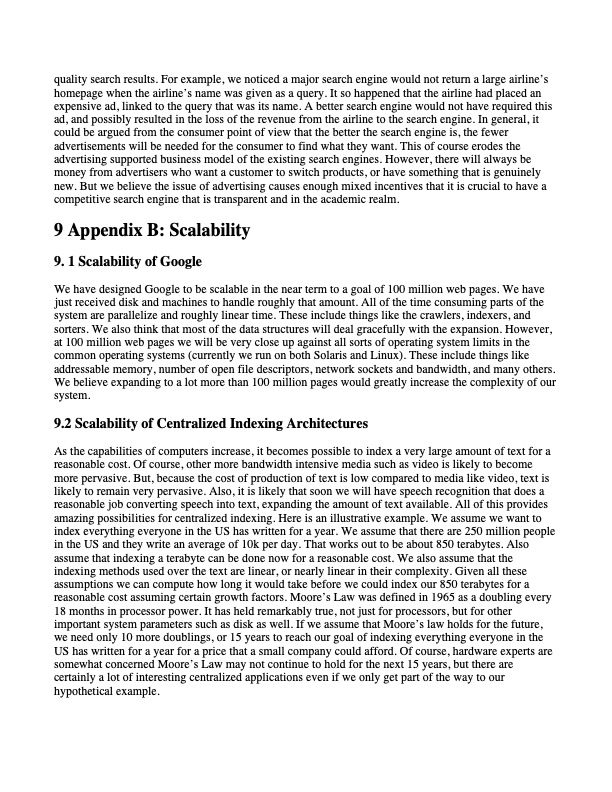
PDF Publication Title:
Text from PDF Page: 019
quality search results. For example, we noticed a major search engine would not return a large airline’s homepage when the airline’s name was given as a query. It so happened that the airline had placed an expensive ad, linked to the query that was its name. A better search engine would not have required this ad, and possibly resulted in the loss of the revenue from the airline to the search engine. In general, it could be argued from the consumer point of view that the better the search engine is, the fewer advertisements will be needed for the consumer to find what they want. This of course erodes the advertising supported business model of the existing search engines. However, there will always be money from advertisers who want a customer to switch products, or have something that is genuinely new. But we believe the issue of advertising causes enough mixed incentives that it is crucial to have a competitive search engine that is transparent and in the academic realm. 9 Appendix B: Scalability 9. 1 Scalability of Google We have designed Google to be scalable in the near term to a goal of 100 million web pages. We have just received disk and machines to handle roughly that amount. All of the time consuming parts of the system are parallelize and roughly linear time. These include things like the crawlers, indexers, and sorters. We also think that most of the data structures will deal gracefully with the expansion. However, at 100 million web pages we will be very close up against all sorts of operating system limits in the common operating systems (currently we run on both Solaris and Linux). These include things like addressable memory, number of open file descriptors, network sockets and bandwidth, and many others. We believe expanding to a lot more than 100 million pages would greatly increase the complexity of our system. 9.2 Scalability of Centralized Indexing Architectures As the capabilities of computers increase, it becomes possible to index a very large amount of text for a reasonable cost. Of course, other more bandwidth intensive media such as video is likely to become more pervasive. But, because the cost of production of text is low compared to media like video, text is likely to remain very pervasive. Also, it is likely that soon we will have speech recognition that does a reasonable job converting speech into text, expanding the amount of text available. All of this provides amazing possibilities for centralized indexing. Here is an illustrative example. We assume we want to index everything everyone in the US has written for a year. We assume that there are 250 million people in the US and they write an average of 10k per day. That works out to be about 850 terabytes. Also assume that indexing a terabyte can be done now for a reasonable cost. We also assume that the indexing methods used over the text are linear, or nearly linear in their complexity. Given all these assumptions we can compute how long it would take before we could index our 850 terabytes for a reasonable cost assuming certain growth factors. Moore’s Law was defined in 1965 as a doubling every 18 months in processor power. It has held remarkably true, not just for processors, but for other important system parameters such as disk as well. If we assume that Moore’s law holds for the future, we need only 10 more doublings, or 15 years to reach our goal of indexing everything everyone in the US has written for a year for a price that a small company could afford. Of course, hardware experts are somewhat concerned Moore’s Law may not continue to hold for the next 15 years, but there are certainly a lot of interesting centralized applications even if we only get part of the way to our hypothetical example.PDF Image | natomy of a Large-Scale Hypertextual Web Search Engine

PDF Search Title:
natomy of a Large-Scale Hypertextual Web Search EngineOriginal File Name Searched:
google-anatomy-of-a-search-engine.pdfDIY PDF Search: Google It | Yahoo | Bing
Cruise Ship Reviews | Luxury Resort | Jet | Yacht | and Travel Tech More Info
Cruising Review Topics and Articles More Info
Software based on Filemaker for the travel industry More Info
The Burgenstock Resort: Reviews on CruisingReview website... More Info
Resort Reviews: World Class resorts... More Info
The Riffelalp Resort: Reviews on CruisingReview website... More Info
| CONTACT TEL: 608-238-6001 Email: greg@cruisingreview.com | RSS | AMP |